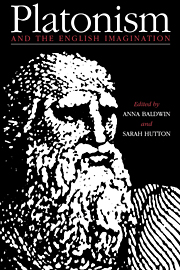Book contents
- Frontmatter
- Contents
- Notes on contributors
- Preface
- I ANTIQUITY
- II THE EARLY CHRISTIAN PERIOD AND THE MIDDLE AGES
- 2 Introduction
- 3 The Christian Platonism of St Augustine
- 4 Boethius and King Alfred
- 5 Chaucer's use of Neoplatonic traditions
- 6 Platonism in the Middle English Mystics
- III THE RENAISSANCE AND THE SEVENTEENTH CENTURY
- IV THE EIGHTEENTH CENTURY
- V THE NINETEENTH CENTURY
- VI THE TWENTIETH CENTURY
- Bibliography
- Index
2 - Introduction
Published online by Cambridge University Press: 15 December 2009
- Frontmatter
- Contents
- Notes on contributors
- Preface
- I ANTIQUITY
- II THE EARLY CHRISTIAN PERIOD AND THE MIDDLE AGES
- 2 Introduction
- 3 The Christian Platonism of St Augustine
- 4 Boethius and King Alfred
- 5 Chaucer's use of Neoplatonic traditions
- 6 Platonism in the Middle English Mystics
- III THE RENAISSANCE AND THE SEVENTEENTH CENTURY
- IV THE EIGHTEENTH CENTURY
- V THE NINETEENTH CENTURY
- VI THE TWENTIETH CENTURY
- Bibliography
- Index
Summary
The story of the influence of Plato and the Neoplatonists on English literature cannot be told without some explanation of how these pagan ideas were Christianised. The original Greek texts were scarcely translated into Latin at all, and so were in a way lost until their rediscovery and complete translation in the Renaissance.But they were assimilated by key authors who had indeed read some Greek originals, and they were both transformed into something compatible with Christianity, and themselves became a major influence upon Christianity. It is this story which I will now briefly outline, to provide a context for the four chapters which follow.
The process of transformation was made all the easier by the fact that Middle Platonism was itself one of the intellectual influences upon the New Testament. This influence is generally traced to the work of Philo, a Jewish philosopher who lived in Alexandria from about 20bc to ad50, and who made a systematic attempt to Hellenise Jewish theology, using (among others) Platonic and Stoic ideas. His account transformed the anthropomorphic Deity of much of the Old Testament into an immaterial Being, above space and time, whose manifestation in this world is through the logos (Word), described (to quote Chadwick), as ‘“the second God”, the pattern and mediator of the creation, the archetype of human reason'. Acting very much as the Demiurge in Plato's Timaeus, the logos makes the material world in imitation of the Divine incorporeal world, but out of an inferior material.
- Type
- Chapter
- Information
- Platonism and the English Imagination , pp. 21 - 26Publisher: Cambridge University PressPrint publication year: 1994
- 1
- Cited by

